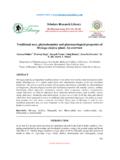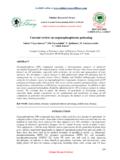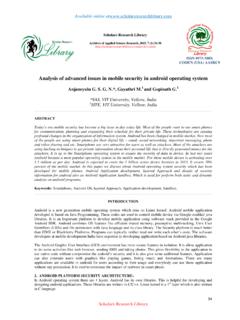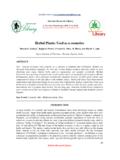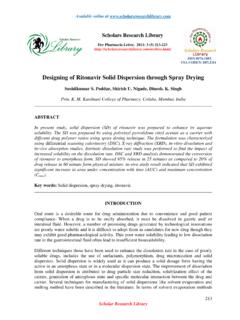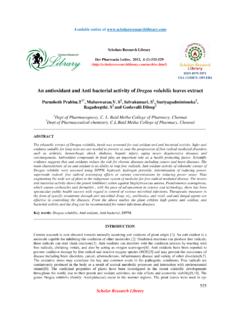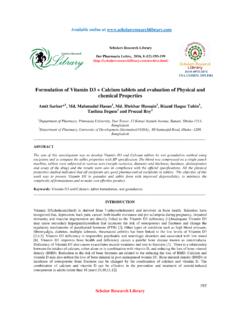Transcription of Quantitative estimation of tannins by HPLC
1 Available online a Scholars Research Library Der Pharmacia Lettre, 2016, 8 (3):123-126 ( ) ISSN 0975-5071 USA CODEN: DPLEB4 123 Scholar Research Library Quantitative estimation of tannins by HPLC Trupti P. Durgawale1, Pratik P. Durgawale2 and Chitra C. Khanwelkar3 candidate, Department of Pharmacology, Krishna Institute of Medical Sciences Deemed University, Karad, Maharashtra, India 2 Research Officer, Molecular and Genetics Laboratory, Krishna Institute of Medical Sciences Deemed University, Karad, Maharashtra, India 3 Professor and Head of Department, Department of Pharmacology, Krishna Institute of Medical Sciences Deemed University, Karad, Maharashtra, India _____ ABSTRACT A High Performance Liquid Chromatography method has been developed and Quantitative estimation of tannins in Pueraria tuberosa (Fabaceae) using aqueous extract, very simple method has been performed.
2 Nucleosil C18 column was used with methanol (HPLC Grade) and water as mobile phase with ratio (50:50) with pH , at flow rate of 1 mL/min, UV detection performed at 270 nm. Total run time was 12 min and tannic acid was eluted at retention time of minute. Calibration plots of tannic acid standard were linear over concentration range 0-60 g/mL with respect to the mean area. Keywords: Pueraria tuberose, tannins , HPLC _____ INTRODUCTION Pueraria tuberosa (Roxb. ex Willd. DC, family: Fabaceae) is a perennial climber found throughout the Indian subcontinent in wet and damp areas. The tuberous roots of this plant are used in Indian traditional medicine (Ayurveda) in general debility, nervous breakdown, spermatorrhoea, burning sensation, heart diseases, intrinsic hemorrhage, tuberculosis etc. The chemical constituents have been identified as puerarin, diadzein, daidzin, -sitosterol and sigmasterols.
3 Puerarin (isoflavones) has been reported to possess anti-fertility, anti-hypertensive, anti-hyperglycemic, nootropic, and neuroprotective effects [1]. Considering the varied important activities reported in traditional system of medicine with this plant, it was planned to study the effects of tubers extracts of P. tuberosa DC for its antidiabetic activity [2]. tannins (commonly referred to as tannic acid) play an important role and have wide applications. tannins are water-soluble polyphenols that are present in many plant foods. They have been reported to be responsible for decrease in feed intake, growth rate, feed efficiency, net metabolizable energy, and protein digestibility in experimental animals. Therefore, foods rich in tannins are considered to be of low nutritional value. However, recent findings indicate that the major effect of tannins was not due to their inhibition on food consumption or digestion but rather the decreased efficiency in converting the absorbed nutrients to new body substances.
4 The anti-carcinogenic and anti-mutagenic potentials of tannins may be related to their anti-oxidative property, which is important in protecting cellular oxidative damage, including lipid peroxidation. The anti-microbial activities of tannins are well documented. The growth of many fungi, yeasts, bacteria and viruses was inhibited by tannins . It has also been reported that tannic acid and propyl gallate, but not gallic acid, were inhibitory to food-borne bacteria, aquatic bacteria and off-flavor-producing microorganisms. Their anti-microbial properties Trupti P. Durgawale et al Der Pharmacia Lettre, 2016, 8 (3):123-126 _____ 124 Scholar Research Library seemed to be associated with the hydrolysis of ester linkage between gallic acid and polyols hydrolyzed after ripening of many edible fruits. tannins in these fruits thus serve as a natural defense mechanism against microbial infections.
5 tannins have also been reported to exert other physiological effects, such as accelerating blood clotting, reducing blood pressure, decreasing the serum lipid level, producing liver necrosis, and modulating immunoresponses [3]. MATERIALS AND METHODS Tannic Acid (analytical grade), methanol and water (HPLC grade) were purchased from S D fine chemicals, Mumbai and tuber of Pueraria tuberosa was provided as a gift sample by Mr. Vivek Gourbroom. Preparation of extract: Aqueous Extract About 100 g of tuber powder was taken in a round bottom flask (2000 mL capacity) and macerated with 500 mL distilled water and 10 mL of chloroform as preservative for 24 hr with occasional shaking every hour; then the marc was removed by filtering the extract, and was concentrated on water bath at 50 C. It was then kept in refrigerator below 4 C till experimental study.
6 Preparation of mobile phase The mobile phase was prepared by mixing methanol and water in ratio of 50:50 and filtered through m filter, using vacuum pump and sonicated for 30 min [4, 5, 6]. Preparation of calibration curve of tannic acid Tannic acid (10 mg) was dissolved in 10 mL of mobile phase to prepare stock solution with concentration of 1000 g/mL. A series of dilutions with concentration of 20, 30, 40, and 50 g/mL were prepared by taking aliquots of , , , and mL of stock solution (1000 g/mL) and diluted up to 10 mL with mobile phase. Each dilution (20 L) was injected with the help of a syringe in triplicate and the area under curve at 270 nm was recorded. Calibration curve of mean area against concentration was plotted (Figure 1). Preparation of sample 10 mg sample was dissolved in 10 mL of mobile phase and allowed to stand for 8 hr with occasional stirring and filtered through m filter and sonicated for 30 min.
7 Quantification was carried out using an absolute calibration curve method with standard solutions of Tannic acid. The chromatographic conditions for analysis were as mentioned in Table 1. Table 1: Chromatographic conditions for Quantitative estimation of tannins Parameters Chromatographic conditions HPLC System Agilent Pump LC-P-100 Detector LC-UV-100 UV/VIS Detector Column Nucleosil C18 5 m particle size, L = 25 cm mm Column temperature Ambient Mobile phase Methanol: Water (50:50) Wavelength of detection 270 Flow rate 1mL/min Sample volume 20 L Run time 12 min Retention time min RESULTS AND DISCUSSION Quantitative estimation of tannins by HPLC: 1. Calibration curve of Tannic acid In the present study, a method was developed by using HPLC for Quantitative estimation of tannins in aqueous extracts of Pueraria tuberosa using tanninc acid as standard and methanol water (50:50) with pH as mobile phase.
8 Calibration curve of mean area against concentration of varying concentrations of tannic acid standard was plotted (Figure 1) as per calculations stated in Table 2. Trupti P. Durgawale et al Der Pharmacia Lettre, 2016, 8 (3):123-126 _____ 125 Scholar Research Library Table 2: Calculations for plotting the tannic acid standard curve Conc. ( g/mL) Injection 1 Area Injection 2 Area Injection 3 Area Mean Area Std. dev. % RSD Mean % RSD 10 12995770 12773973 12975660 12915134 122662 20 21846410 19402462 20836590 20695154 1228098 30 31302615 32310422 31302616 31638551 581857 40 40421089 39923299 38922590 39755659 763186 50 49633853 50979076 50289170 50306465 776695 60 58533712 55507297 57547198 57196069 1543459 Sample 50 g/ml 13937665 14130444 14120272 14062794 108484 . Figure 1: Calibration curve of mean area against concentration of tannic acid standards A representative chromatogram of tannic acid standard 50 g/mL (injection # 3) has been given in Figure 2.
9 The retention time for tannic acid standard was about minutes with USP plate count of 562 and asymmetry factor of Figure 2: Chromatogram of tannic acid standard 50 g/mL (injection # 3) AQUEOUS EXTRACT: 50 g/mL of sample solution was prepared and 20 L was injected in the same chromatographic conditions as the tannic acid standards. The chromatogram of injection # 1 has been represented in Figure 3 below. The retention time of tannic acid peak was and asymmetry factor was y = 909588x + 4E+06R = AreaConcentration ( g/mL)Trupti P. Durgawale et al Der Pharmacia Lettre, 2016, 8 (3):123-126 _____ 126 Scholar Research Library Figure 3: Chromatogram of aqueous extract injection # 1 (50 g/mL) Calculation: By using following formula the Quantitative estimation of tannins by HPLC is calculated. All the values considered are mean values of triplicate injections of standard (50 g/mL) and sample (50 g/mL) mentioned in Table 2.
10 Conc. of standard = AUC of standard Conc. of sample AUC of sample Conc. of sample = Conc. of standard/AUC of standard AUC of sample Conc. of sample = . / 14062794 Conc. of sample = mg/mL of tannic acid = g/mL of tannic acid According to the mentioned data, 50 g/mL of aqueous extract of Pueraria tuberosa contained g/mL of tannic acid. To further investigate the HPLC-based method, it can be validated preferably using ICH guidelines and mass spectrometric confirmation can be done. Acknowledgement The authors would like to convey their gratitude towards Mr.

